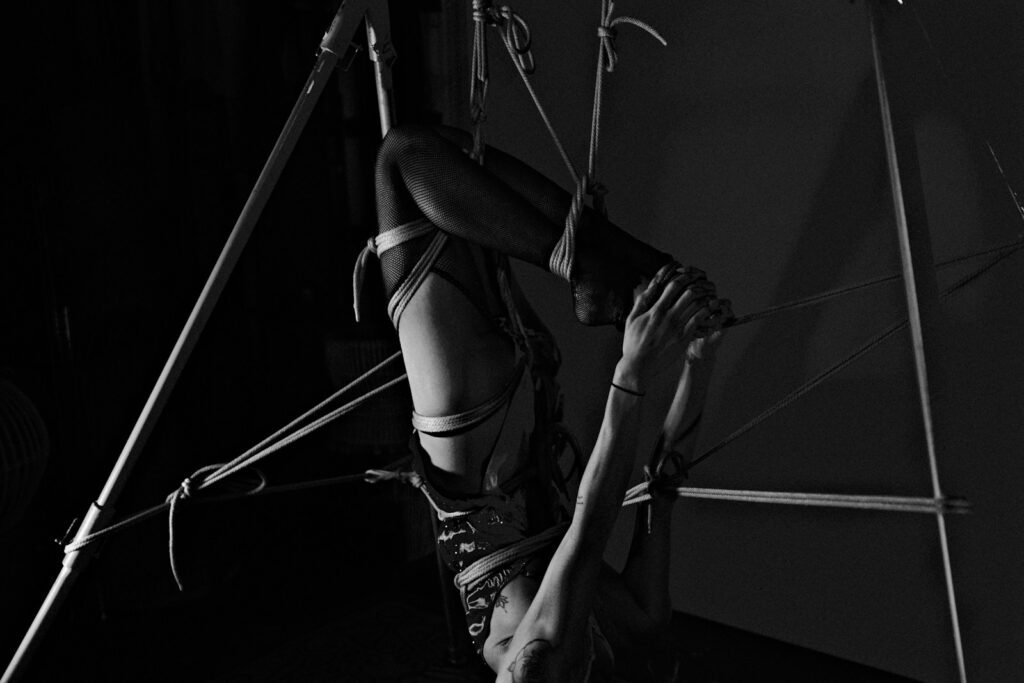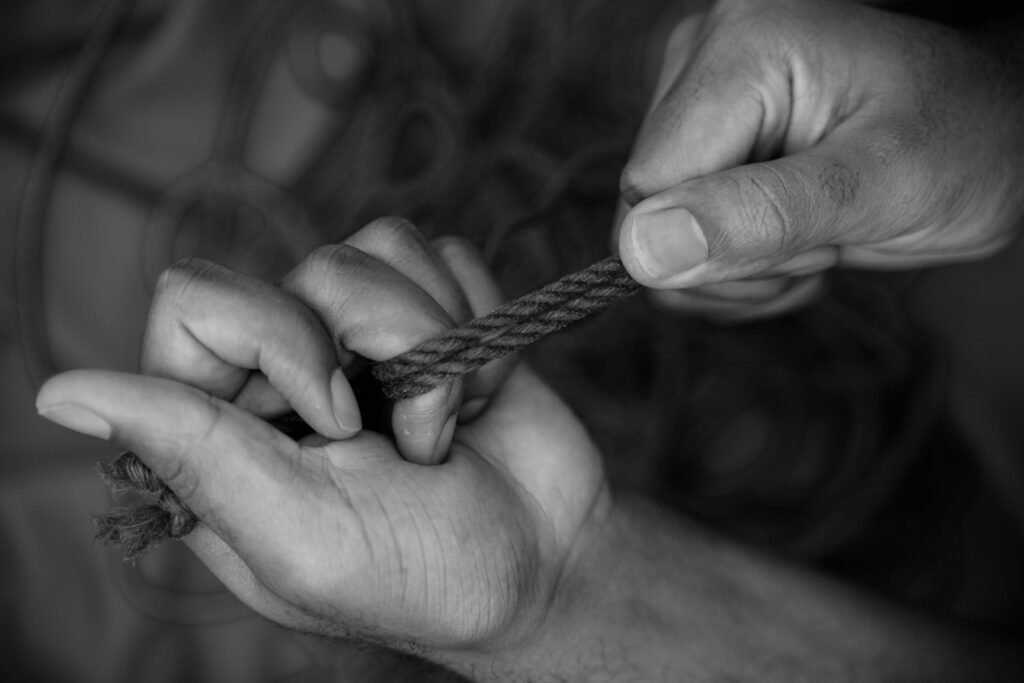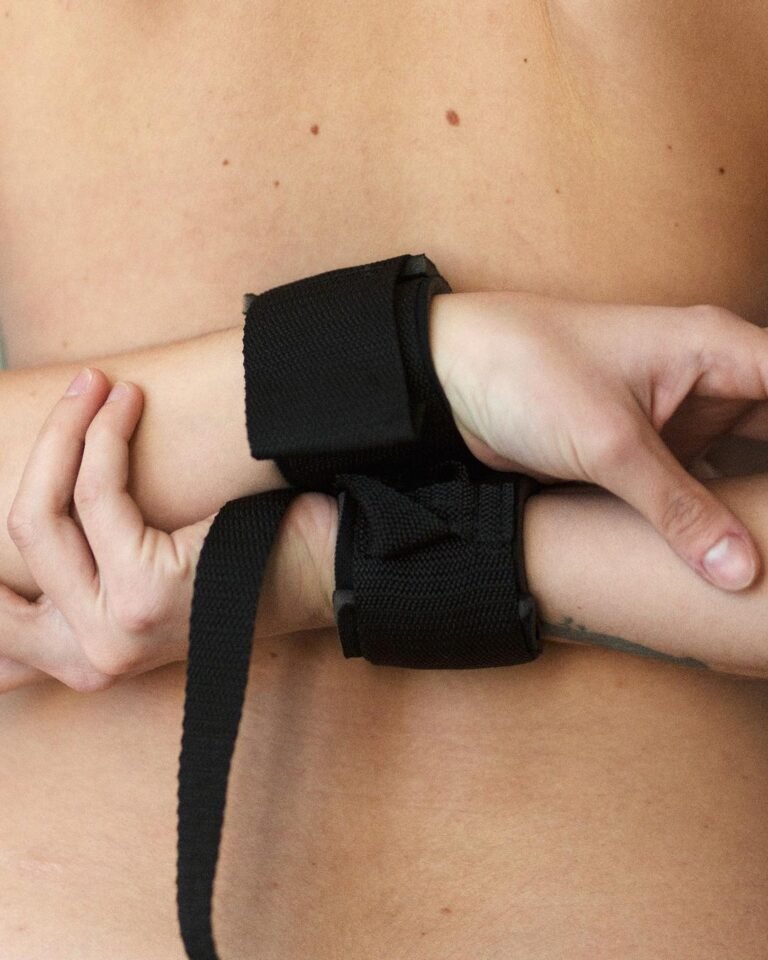Shibari Suspension: A Beginner’s Guide to This Intricate Artform
If you’ve ever seen those breathtaking images of people gracefully suspended in intricate rope patterns, you’ve probably come across Shibari suspension. This Japanese artform, rooted in centuries-old techniques, has become a popular practice in modern BDSM and alternative lifestyle communities. But what exactly is Shibari suspension? And how can you get started with it? Let’s dive in and unravel the ropes (pun intended)!
Shibari is not just about tying someone up for fun; it’s an intricate mix of skill, art, and trust. Whether you’re curious about trying it for yourself or simply interested in learning more, you’re in the right place. I’ll share what I know from personal experience and give you the lowdown on the basics of Shibari suspension!
What Is Shibari Suspension?
Shibari suspension is an advanced form of rope bondage where a person is tied using intricate, beautiful rope patterns and then lifted off the ground, often into the air. This practice takes traditional Shibari, which is known for its detailed and artistic rope work, and adds the element of suspension. The result is not only visually stunning but also creates a unique physical and emotional experience.
The Art of Shibari
Shibari, originally a Japanese practice, involves creating beautiful, intricate rope patterns on the body, with each knot and weave designed to be visually appealing as well as functional. When suspension is introduced, the art form evolves. It’s no longer just about the visual beauty of the knots but also about how the ropes interact with gravity and the person’s body. It’s this suspension aspect that sets Shibari apart from traditional bondage. The person being tied is physically lifted, creating a striking blend of restraint, artistry, and trust.
Trust and Intimacy in Shibari Suspension
One of the most crucial aspects of Shibari suspension is the trust it requires between the person doing the tying (the rigger) and the person being tied (the model or bottom). Because suspension involves being lifted off the ground, it requires a high level of communication and understanding. The person in the ropes has to trust that the person tying them will ensure their safety and comfort throughout the process.
This deep level of trust makes Shibari suspension an intimate experience. The connection formed between both participants is not only physical but emotional, as they rely on each other for safety and control during the suspension.
The Role of Gravity in Suspension
When a person is suspended in the air, gravity becomes an important factor. The weight of the body is distributed in unique ways depending on the position of the ropes. The person tied is often suspended by points on their body, such as their arms, legs, or torso, depending on the suspension technique. Each suspension style provides a different experience, ranging from more intense, full-body suspensions to lighter, more decorative positions that focus on aesthetic beauty.
The physical sensation of being suspended can be both exhilarating and calming, as the body experiences a form of freedom while being fully supported by the ropes. This feeling of surrender, combined with the sensory experience, can lead to heightened emotional and physical responses, making Shibari suspension a powerful practice for those involved.
The Complexity of Shibari Suspension
Unlike basic bondage, Shibari suspension is a complex skill that requires significant practice and understanding of both rope techniques and human anatomy. The person tying needs to be well-versed in safety protocols, as improper knots or suspension techniques can lead to injury. This is why many people who practice Shibari suspension do so after considerable training and under the guidance of experienced practitioners.
There are different types of suspension, each with varying levels of difficulty and risk. Some common suspension styles include the “shinju” (a chest suspension) and “koshin” (waist suspension). Each style requires precise knotting techniques and an understanding of how the ropes should distribute the body’s weight for safety and comfort.
A Visual and Sensory Experience
One of the main draws of Shibari suspension is its visual appeal. The intricate knots and delicate placement of ropes can transform the human body into a living piece of art. The patterns formed by the ropes can be breathtaking, with a sense of harmony between the person’s body and the ropes. For those who appreciate the visual art of rope, suspension creates an opportunity to explore both beauty and tension, as the lines of rope contour to the curves of the body.
Beyond the visual, the sensory experience of suspension is also deeply immersive. The feeling of the ropes, the sensation of being suspended, and the emotions that arise from the entire experience can make Shibari suspension a profound and sometimes meditative practice.

A Beginner’s Guide to Getting Started with Shibari Suspension
If you’re new to Shibari suspension, it’s important to approach it with patience and care. This practice can be deeply rewarding, but it requires a good understanding of the ropes, trust, and safety. Here’s a beginner’s guide to help you take those first steps and navigate this exciting yet complex world of rope bondage.
Start with the Basics: Mastering Knots First
Before you can even think about suspension, it’s essential to first learn the basic knots used in Shibari. These knots are the foundation of all rope bondage, and skipping this step can lead to a lack of control or safety issues. Simple knots, such as the single column tie, double column tie, and square knot, are often used to create stable, secure connections between ropes and the body. These knots allow for flexibility in how the rope is applied and can help avoid unnecessary strain or injury.
Learning these basic knots might take time, but it’s crucial to practice them until you can tie them comfortably and confidently. There are plenty of resources available—online tutorials, workshops, or even books focused on Shibari—that will guide you through the basics step by step. Building a solid foundation will allow you to progress smoothly as you move on to more advanced techniques like suspension.
Find a Partner You Trust
Shibari suspension is not something you should attempt alone, and trust plays a vital role in making the experience both safe and enjoyable. A key part of Shibari is the connection between you and your partner, especially when suspension is involved. Whether you’re the one doing the tying or the one being tied, clear communication and mutual respect are essential.
It’s important to find a partner who is not only familiar with the ropes but also someone you can rely on in moments of vulnerability. The person tying you (the rigger) will need to have a good understanding of rope safety, how to tie securely, and how to manage any risks involved. For those starting out, it’s always recommended to find someone with experience who can guide you through the process, ensuring your safety and comfort.
Safety and Communication Are Key
When it comes to Shibari suspension, safety and communication aren’t just important—they’re absolutely essential. Whether you’re the one doing the tying or the one being tied, you need to be aware of each other’s physical and emotional boundaries and have clear communication throughout the entire process. This practice involves a lot of trust, and ensuring both parties feel comfortable and secure is key to having a positive experience.
Know Your Limits: Communicate Boundaries
Before you even start the tying process, it’s crucial to have an open conversation about each other’s limits and boundaries. Both partners should feel comfortable sharing what they’re okay with and what they’re not comfortable with. Being honest and clear about your physical and emotional limits will create a safer environment for both people involved.
If you’re new to Shibari suspension, don’t feel pressured to try advanced techniques right away. Start by discussing what you’re comfortable with and taking it slow. Maybe you’re interested in trying a partial suspension or you want to avoid certain positions altogether—whatever your preferences, be upfront about them.
Remember, it’s okay to change your mind during the process. Consent isn’t a one-time conversation—it should be ongoing. For example, if you’re the one being tied up, and you start to feel uncomfortable or anxious, communicate that immediately. Likewise, if you’re the rigger and you feel that something isn’t quite right with the tie or your partner’s comfort, it’s important to speak up.
Clear, honest communication can make all the difference in making sure both people feel safe, respected, and in control. Taking time to discuss what you want to try before the session will also help set expectations and ensure that everyone feels heard.
Learn to Recognize Warning Signs: Be Mindful of Red Flags
Being aware of warning signs during the suspension process is critical to your safety. It’s important to be mindful of how your body feels when you’re tied up and suspended. Loss of circulation, numbness, tingling, dizziness, or even pain are all signs that something isn’t right and should never be ignored. These symptoms could indicate that a rope is too tight, or pressure is being applied to a sensitive area, and immediate action should be taken to release the tension or adjust the ropes.
Always keep an eye on your partner’s physical state as well. If you’re the one doing the tying, regularly check in with your partner to ensure they’re feeling comfortable and that there’s no discomfort or pressure building up in any areas. If you’re the one being tied up, make sure to give feedback to your rigger if you begin feeling any discomfort, even if it’s mild. It’s much easier to make adjustments earlier on than to wait until a problem becomes serious.
Being able to recognize these warning signs and act quickly can help prevent more serious injuries. A good practice is to check in with your partner throughout the session—just a simple “how are you doing?” or “does this feel okay?” can go a long way in ensuring that both people feel safe and cared for.
Have a Safety Plan in Place: Quick Release Is Essential
Shibari suspension is a beautiful and intense experience, but it can also be risky, especially if something goes wrong. That’s why it’s crucial to have a solid safety plan in place before you begin. Having a plan will ensure that both partners know exactly what to do if an emergency occurs.
First and foremost, always keep safety shears or scissors within arm’s reach. These are essential tools that can quickly cut through the rope in case of an emergency. Make sure that the shears are sharp and that both partners know where they are and how to use them. In an emergency, every second counts, and having the proper tools available could make all the difference.
Before you start, also talk about how to quickly release someone from suspension if necessary. This may mean having a procedure for releasing tension from the ropes or knowing how to safely lower someone back to the ground. Being familiar with these processes before you’re in a stressful situation will help you remain calm and focused if something unexpected happens.
Additionally, it’s important to establish a safe word or signal. Sometimes verbal communication may not be possible during suspension, especially if you’re in a position where it’s difficult to speak. Having a clear, agreed-upon safe word or hand signal can give your partner a way to signal if they’re feeling uncomfortable or need to stop.
Trust Your Instincts: Always Stop If Something Feels Wrong
In any Shibari session, the most important thing to remember is that it’s okay to stop if something feels off. Both the rigger and the person being tied should trust their instincts and not push through any discomfort, pain, or uncertainty. If something feels unsafe, don’t hesitate to call for a stop, even if it’s at the beginning, middle, or end of the session.
Being able to stop at any time helps create an environment where both partners feel in control and comfortable. It also ensures that you don’t put yourself or your partner at risk by continuing with a situation that may not be safe. Remember, Shibari suspension is about mutual trust and respect—it’s not about pushing past limits or enduring pain for the sake of the experience. It’s about creating something beautiful and meaningful together, so always prioritize comfort and safety.
Post-Suspension Check-In: Don’t Skip Aftercare
After the suspension is over, the safety conversation doesn’t end. Aftercare is a crucial part of the process for both the rigger and the person who was suspended. When the ropes are released, the body can experience a sudden rush of blood, and some areas may feel stiff or sore from being tied for an extended period. This is normal, but it’s important to take care of each other after the session is over.
If you’re the one being suspended, it’s important to take your time coming down from the experience. Stretching, hydrating, and being gentle with your body are key parts of aftercare. Likewise, the rigger should offer emotional support and check in to make sure that their partner feels comfortable both physically and mentally after the suspension.
Aftercare can also involve cuddling, talking, or simply sitting together in a calm and relaxed environment. It’s a great way to deepen the emotional connection between both partners and ensure that the experience was positive for everyone involved.
Safety and communication are fundamental aspects of Shibari suspension. Taking the time to discuss boundaries, recognize warning signs, and have a safety plan in place will ensure that you have an enjoyable and secure experience. Always prioritize trust, and never feel afraid to stop or ask for help if something doesn’t feel right. By keeping safety at the forefront, you can fully enjoy the artistic and intimate nature of Shibari suspension.
Shibari Suspension as Art and Expression
Shibari suspension is much more than a physical act—it’s a powerful form of visual art and personal expression. At its core, Shibari is about creating intricate, beautiful patterns with rope, but what truly makes it stand out is how it evokes emotion and tells stories through its structure. The visual appeal of Shibari comes from the intricate knots, the patterns they form, and how they interact with the human body. Each rope tie is a work of art that’s both delicate and powerful at the same time, capturing a moment in time where the rope becomes an extension of the human form, expressing trust, vulnerability, and intimacy.
Aesthetic Beauty in Shibari Suspension
One of the most fascinating aspects of Shibari suspension is the sheer aesthetic beauty it creates. The knots and patterns, whether simple or complex, work together to form an intricate web of lines that flow with the body’s shape. These ropes trace the contours of the body, accentuating its natural form, creating visual tension that can be both striking and mesmerizing. The patterns themselves can range from minimalist to highly elaborate, and it’s this visual artistry that draws many people to the practice.
When you look at a person suspended in Shibari, it’s not just the ropes that catch your eye, but the way the person becomes part of the artwork. Their body becomes an intricate canvas, and the ropes act as brushstrokes, creating movement and texture that tell a deeper story. The suspension element adds to this, elevating the subject into space and allowing the viewer to witness not just the still beauty of the ropes, but the dynamic interplay of gravity and balance.
The skill of the rigger also plays a huge role in the artistry of Shibari. The way they weave the ropes around the body, creating harmony, tension, and balance, takes time and expertise to master. For many, this is not just a skill—it’s a form of personal expression and creativity. It’s about crafting a piece of art that is both visually appealing and emotionally resonant, whether for the person being tied or the observer.
Shibari Suspension as Emotional Expression
Beyond the visual artistry, Shibari suspension is a deeply emotional experience for those involved. It’s often used as a tool for exploring different themes, such as power dynamics, trust, vulnerability, and even spiritual growth. These themes are woven into the very fabric of Shibari, where the rope itself becomes a metaphor for connection and control, trust and surrender. The act of tying someone up—suspending them in the air—can represent a wide array of emotions and dynamics.
For example, some people use Shibari to explore power exchange. The person being tied may submit to the rigger, allowing themselves to be controlled, while the rigger takes on the role of providing care, direction, and control. This can create a sense of power dynamics that are safe, consensual, and deeply intimate. It’s an experience of giving and receiving trust in a very raw and vulnerable way.
On the other hand, some use Shibari suspension as a form of emotional release or self-exploration. The person being suspended may feel a sense of vulnerability, surrender, and acceptance, which can lead to deep personal growth. The act of being tied up and suspended can represent letting go of control and fully trusting the person doing the tying, and in some cases, even the ropes themselves. The experience can feel transformative, offering a sense of release from mental or emotional burdens.
For others, Shibari suspension may have a spiritual dimension. In certain cultures, rope bondage has been used as a way to express deep connection with one’s body, the earth, and the universe. The act of suspension can bring about a state of mindfulness and presence, allowing the individual to experience a moment of stillness and focus that can be deeply meditative. The ropes can serve as a symbol of the ties that bind us not only to each other but to ourselves.
Shibari Suspension as a Means of Building Trust and Connection
At its heart, Shibari suspension is a practice of profound trust. It requires the person being tied to surrender control and trust the rigger completely. This can create an intense bond between the two individuals, as the act of suspending someone requires a deep level of responsibility, care, and attentiveness. The rigger must be aware of the person’s physical and emotional needs, adjusting the ropes as necessary to ensure comfort and safety. Meanwhile, the person being tied must trust that their rigger has their best interests in mind, that the tie will be secure, and that their safety is a priority.
This trust is not just about physical safety—it’s about emotional security. The process of being tied and suspended can be incredibly intimate, often requiring the person being tied to open up in a way that they may not in other circumstances. They must trust that their vulnerability will be respected and cared for, which creates a deep sense of emotional intimacy between the two partners.
Shibari Suspension as a Form of Storytelling
Shibari suspension can also be used as a way to tell a story or convey a message. Each tie, each pattern, can symbolize something unique. For instance, a specific knot might represent strength, while another might symbolize connection or freedom. The way the ropes are positioned and how the body is suspended can express different emotions, power dynamics, or even personal narratives.
Some people use Shibari to communicate a journey—whether that journey is physical, emotional, or spiritual. For example, a tie that starts at the feet and gradually moves upwards toward the chest could symbolize a rise from struggle to strength. A more complex, intricate pattern may tell a story of layers and complexity, showing the intertwining of the person’s emotions, history, and present experience.
The rope becomes more than just a tool; it’s an instrument of expression, allowing the rigger and the person being tied to explore and communicate feelings that might be difficult to articulate with words. This storytelling aspect of Shibari is what draws many people to the art form—it’s a creative outlet that merges physicality with emotion, offering a unique and powerful way to communicate and connect.
Shibari suspension is far more than just an activity; it’s a beautiful, expressive artform that combines physical techniques with emotional depth. Whether you see it as a way to explore power dynamics, personal vulnerability, or even spiritual growth, it offers endless possibilities for self-expression and connection. The intricate patterns created by the rope, the trust built between partners, and the stories told through suspension all contribute to making Shibari an art that’s as deep as it is visually stunning.

Embracing the Beauty of Shibari Suspension
Shibari suspension is undoubtedly one of the most visually captivating and emotionally intense practices in the world of rope bondage. The act of suspending someone in midair, with the intricate patterns and knots weaving around their body, creates a sense of beauty that transcends the physical. It’s a form of art, an emotional connection, and a dynamic experience all at once. Whether you want to incorporate it into your personal relationships, explore the emotional depth it offers, or simply admire the skill and artistry behind it, there’s no denying that this form of suspension is something truly extraordinary.
A Journey into Trust and Connection
Shibari suspension, at its core, is about building trust. This practice isn’t just about the ropes; it’s about the relationship between the person being tied and the one doing the tying. It’s an intimate experience that invites vulnerability, mutual respect, and deep connection. The suspension itself might seem like the focal point, but the true essence of Shibari lies in the trust that is built between the individuals involved.
Whether you’re the person being suspended or the one tying the knots, you’re both engaged in an exchange of trust. The person being tied must rely on the rigger to ensure their safety and comfort, while the rigger, in turn, must be attuned to the needs and well-being of the person they’re tying. This shared understanding fosters not only physical connection but also an emotional bond that can strengthen your relationship and create a sense of unity. The experience can be incredibly intimate, as you communicate without words, conveying trust, care, and closeness through every knot and suspension.
The Artistic and Personal Growth Aspect
Beyond the emotional connection, Shibari suspension offers an artistic outlet for both the rigger and the person being suspended. The process of creating beautiful rope patterns and designing an aesthetically pleasing suspension takes skill, creativity, and practice. The symmetry and lines of the rope as they interact with the human body create stunning visuals that captivate and inspire.
For the rigger, learning the craft is a journey of artistic growth. It involves mastering various knots, understanding body mechanics, and practicing safety protocols to ensure a seamless and beautiful suspension. It’s a form of expression, where the rigger can let their creativity flow through the ropes, crafting something unique and meaningful for each session.
For the person being suspended, the experience can lead to personal growth. The vulnerability of being tied and suspended can encourage self-awareness, body acceptance, and a deepened connection to one’s own physicality. It can also serve as an emotional release, helping to process feelings and overcome personal challenges. The experience of surrendering to the ropes and the rigger can be incredibly empowering and transformative.
Exploring Power Dynamics and Emotional Depth
Shibari suspension also opens the door for exploring power dynamics in a safe, consensual way. The act of being suspended can symbolize both power and vulnerability. In some cases, it’s an exploration of dominance and submission, where the person being tied surrenders control, and the one doing the tying assumes a position of care and leadership. It’s a nuanced dynamic that can evoke feelings of empowerment, submission, or even a mix of both.
But it’s important to remember that power dynamics in Shibari are not about control for control’s sake; they are about mutual respect, consent, and emotional depth. The beauty of Shibari lies in how these dynamics can be navigated thoughtfully and with care. The connection between the rigger and the person being suspended is built on clear communication and understanding, ensuring that both parties are comfortable, respected, and emotionally present throughout the experience.
Shibari as a Spiritual Practice
For some, Shibari suspension takes on a spiritual dimension. The practice can create a profound sense of mindfulness and presence, encouraging the individual to be fully in the moment. Whether it’s through the meditative act of tying the ropes or the experience of being suspended, Shibari can be a form of moving meditation. It invites a deep connection to the body and to the sensations of the ropes, creating a moment of stillness and focused awareness.
The act of suspension itself can feel like a release from worldly concerns, as gravity and tension pull you into a state of heightened presence. It’s a way to explore the relationship between the physical body and the mental or spiritual self. In some traditions, rope bondage and suspension have been used as a means of spiritual growth, where the act of surrendering to the ropes symbolizes letting go of attachments and embracing the present moment.
Preparing for Your Shibari Suspension Journey
If you’re considering diving into Shibari suspension, take your time. There’s no rush—this is a journey that requires patience, practice, and a commitment to learning. Start slow, and don’t be afraid to ask questions, whether you’re the person being tied or the one tying. The key is to approach Shibari with a sense of curiosity and respect for the craft, and above all, for the person you’re engaging with.
Remember, Shibari is about communication, trust, and safety. It’s about building a connection, whether that’s through the artistry of the ropes, the vulnerability of surrender, or the emotional exchange between partners. Take it step by step, and embrace the process as much as the end result.

Stay Safe and Informed
As with any BDSM practice, safety should always be your top priority. While Shibari is an incredibly rewarding practice, it’s essential to ensure that both physical and emotional safety are maintained at all times. Make sure to learn proper techniques, have the right tools, and never neglect the importance of clear communication with your partner.
Stay informed, learn from experienced practitioners, and always respect your boundaries and those of your partner. Take your time with each tie, each suspension, and each knot. The goal is to create something beautiful, not just visually, but emotionally and relationally as well. By prioritizing safety, trust, and communication, you’ll be able to enjoy Shibari suspension to its fullest potential.
Shibari suspension is a journey of artistic exploration, emotional connection, and personal growth. Whether you’re drawn to the beauty of the rope, the trust it builds between partners, or the emotional and spiritual depth it offers, it’s a practice that can transform your understanding of yourself and your relationships. As you learn more, take each step with care, and remember that it’s all about the experience—the art, the trust, and the connection. If you’re ready to take the plunge, start slow, prioritize safety, and enjoy the creative and emotional rewards that come with this incredible practice.





